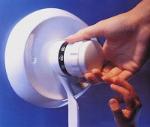Search engine visitors - click here to access entire "$ensible Home" web site
Click here to see a descriptive illustration showing several types of thermostatic shower valves.
Dear Jim: It takes forever to get the shower temperature just right and then my wife flushes a toilet and it changes again. Will one of the new thermostatic control, anti-scald shower/tub valves really help much? - Bob M.

A: Installing a new thermostatic/pressure-balancing bath fixture will hold the shower or bath water temperature steady to within two degrees even through flushed toilets, dishwashing, etc. These fit perfectly as a replacement to your old one and are available in all the contemporary decorator styles.
More important than comfort are the anti-scald safety features of these valves. More than 5,000 children and elderly are scalded each year. At only 130 degrees, a common water heater setting, skin can be scalded in seconds.
A common scald injury is when someone slips in the shower. He bumps the valve handle or grabs at anything as he fall and it gets turned to full hot. If he doesn't move immediately, he can receive serious burns. Also, the elderly often have reduced temperature sensitivity and can unknowingly scald themselves.
Installing a new valve can also lower your water heating costs and water bills. With fluctuating shower temperatures, you often spend a lot of time and waste hot water just trying to adjust the shower water temperature.
These valves operate in three basic ways - 1) by balancing the hot and water pressure at the shower valve to maintain a constant temperature, 2) by actually controlling the hot/cold mixture with a temperature-sensing mechanism or 3) by a combination of both.
You should consider some unique comfort and safety features. Compare the sensitivity in the comfort zone (90 to 110-degrees) range. In this range, it is easy to fine tune the water temperature. New thermostatic whole-body models, like Mastershower, have multiple body spray outlets in one unit for a relaxing shower.
The most convenient and safe models, for a family, are completely electronic. Three different shower/bath water temperatures can be programmed into the unit. Each person selects button one, two or three and the water will stay virtually constant at their desired shower temperatures.
If you use one shower yourself most often, select a thermostatic valve that has separate flow and temperature controls. Every time you take a shower, the water will be precisely the same temperature as the last shower. A valve with an LCD temperature readout or a standard dial is also helpful.
If your budget is limited, purchase simple-to-install shower, faucet and bath scald protectors for about $15. These automatically shut off the water if the temperature gets too high and keeps it off until it cools to a safe level.
Instant Download Update Bulletin No. 556 - buyer's guide of 17 thermostatic/pressure-balancing valves and low-cost scald protectors listing comfort zones, types, safety/convenience/comfort features, simple, do-it-yourself installation instructions and diagrams for an anti-scald device, illustrations, description of severity of burns (firt to fourth degree), chart showing water temperature effects on adult skin.
Dear Jim: I plan to install a radiant floor in my master bathroom. The floor has carpeting now, but I want to remove it and install tile. Is tile a good choice and should I try to lay the tile myself? - Steve M.
A: Tile is one of the best finishing materials for a radiant floor. It has good thermal capacity, does not insulate like carpet and it is durable for a bathroom environment.
The casual do-it-yourselfer generally should not attempt to tile an entire floor. If just one tile is slightly mispositioned, it can throw off the entire pattern alignment. This is usually very noticeable.